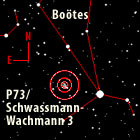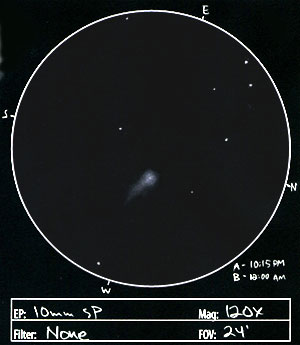Move mouse over upper image for labels.
Observation Notes
 This was my first of what I hope will be many observations of this comet. I found it just east of Arcturus, and even from the less-than-ideal glare in front of my house, it was readily visible. It immediately portrayed a streak-like appearance, which was encouraging. Two stars in the northeast edge of the view (GSC 1483:21 and 1483:24) provided some scale. Those stars are 107" apart, and the comet's coma had a diameter that was a bit more than half that distance--so about 1' in diameter. And the tail seemed to be a bit longer than that distance--about 2' long from pseudo-nucleus to faded out edge.
This was my first of what I hope will be many observations of this comet. I found it just east of Arcturus, and even from the less-than-ideal glare in front of my house, it was readily visible. It immediately portrayed a streak-like appearance, which was encouraging. Two stars in the northeast edge of the view (GSC 1483:21 and 1483:24) provided some scale. Those stars are 107" apart, and the comet's coma had a diameter that was a bit more than half that distance--so about 1' in diameter. And the tail seemed to be a bit longer than that distance--about 2' long from pseudo-nucleus to faded out edge.
The pseudo nucleus was fairly condensed, but seeing was very poor, and I couldn't say if it took on a stellar appearance. Over the course of 1 hour 45 minutes, the comet appeared to move about 2' to the northeast. Checking TheSky planetarium software later revealed the motion to be 2'10" over that time period :D
Factoids
73P/Schwassmann-Wachmann 3 was discovered May 2, 1930 by Arnold Schwassmann and Arno Arthur Wachmann on minor planet survey photographs. During that apparition, the comet passed .0616 AU from Earth and reached between magnitude 6 and 7. During the 1995 apparition, the comet underwent 3 outbursts. Subsequently, it was observed to have broken into 5 nuclei. As of April 4th, 2006, 19 components have been observed. It will pass .08 AU from Earth on May 12, 2006, possible reaching mag. 3.5.
| Subject | 73P/Schwassmann-Wachmann 3 | |
| Classification | Comet | |
| Position* | Boötes 05:15 UT - [RA: 14:42:59 / Dec: +19:55:16] 7:00 UT - [RA: 14:43:06 / Dec: +19:56:38] | |
| Size | Coma: 1' ; Tail: 2' | |
| Brightness* | ~9.5 | |
| Date/Time | April 1, 2006 - 10:15 PM to April 2, 2006 - 10:00 AM MST (April 2, 2006 - 05:15-07:00 UT) | |
| Observing Loc. | Flagstaff, AZ - Home | |
| Instrument | Orion SVP 6LT Reflector (150 mm dia./1200 mm F/L) | |
| Eyepieces/Mag. | 10 mm Sirius Plössl (120X) | |
| Conditions | Clear, breezy, 57°F | |
| Seeing | 3/10 | |
| Transparency | Mag 5.8 NELM | |
| *Sources | Orion's The Sky Software; Cometography;Aerith.net |






Great blog! I'm curious: do you do your sketches black on white and then reverse them to show online? They look great.
Hi Kim,
Thanks for the comment!
The sketches I produce are black pencil on white paper. I then invert them for presentation on the site.
I have a tutorial describing the sketching process here.
And then another describing the digital process here.
I have been practicing with some white on black sketching that involve Conté Crayon pencils. One of the sketches I produced that way is here.
I don't know if you've ever been to a site called "Cloudy Nights", but there is an excellent sketching forum there with a lot of discussion about sketching techniques, tutorials and results from folks who sketch DSOs, the Sun, Moon, and Planets. The sketching forum is about halfway down the page.
I enjoyed taking a trip over to your site. I wish I would have read the caution in your M40 post before hitting the Messier Marathon a couple weeks ago. That nasty critter nearly hung me out to dry because I hadn't researched it ahead of time. Great link on the Body in a Vacuum too. I look forward to checking out the other posts.
Keep up the great work,
Jeremy
I saw piece C by the Ring Nebula last night. A grand site in my Astroscan! Sky was partly cloudy but the effort was worth it. Check it out : )
Hi James, thanks for the comment. The B and C components have been doing great despite the waxing moon. That pairing with M57 was fascinating!